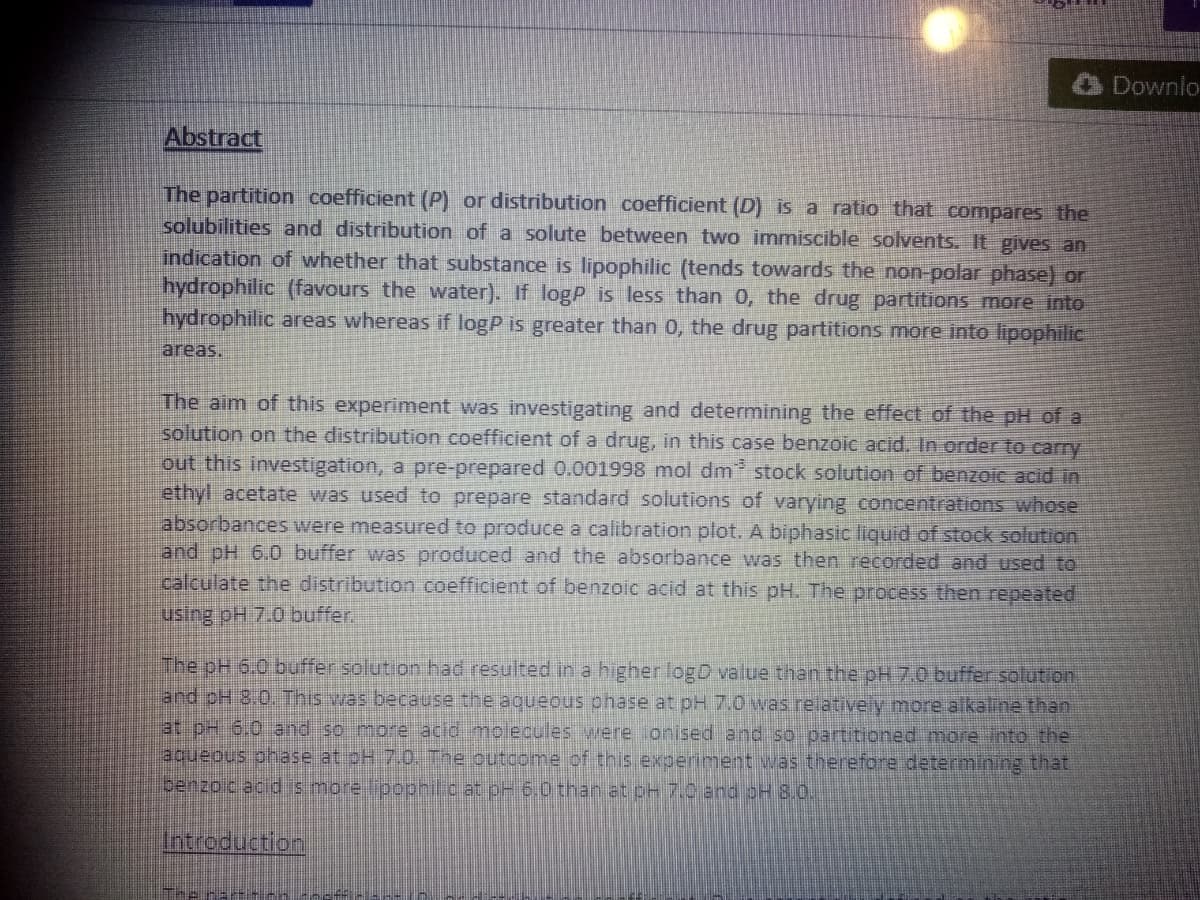Good evening, Could you write me an abstract for the Dependance of Distribution Coefficient Upon pH? Even if its just the first paragraph. There is an example one ive attached below.
Good evening, Could you write me an abstract for the Dependance of Distribution Coefficient Upon pH? Even if its just the first paragraph. There is an example one ive attached below.
Principles of Instrumental Analysis
7th Edition
ISBN:9781305577213
Author:Douglas A. Skoog, F. James Holler, Stanley R. Crouch
Publisher:Douglas A. Skoog, F. James Holler, Stanley R. Crouch
Chapter33: Automated Methods Of Analysis
Section: Chapter Questions
Problem 33.8QAP
Related questions
Question
Good evening,
Could you write me an abstract for the Dependance of Distribution Coefficient Upon pH? Even if its just the first paragraph.
There is an example one ive attached below.
Please help me. ❤️❤️?
Thank you

Transcribed Image Text:Downlo
Abstract
The partition coefficient (P) or distribution coefficient (D) is a ratio that compares the
solubilities and distribution of a solute between two immiscible solvents. It gives an
indication of whether that substance is lipophilic (tends towards the non-polar phase) or
hydrophilic (favours the water). If logP is less than 0, the drug partitions more into
hydrophilic areas whereas if logP is greater than 0, the drug partitions more into lipophilic
areas.
The aim of this experiment was investigating and determining the effect of the pH of a
solution on the distribution coefficient of a drug, in this case benzoic acid. In order to carry
out this investigation, a pre-prepared 0.001998 mol dm stock solution of benzoic acid in
ethyl acetate was used to prepare standard solutions of varying concentrations whose
absorbances were measured to produce a calibration plot. A biphasic liquid of stock solution
and pH 6.0 buffer was produced and the absorbance was then recorded and used to
calculate the distribution coefficient of benzoic acid at this pH. The process then repeated
using pH 7.0 buffer.
The oH 6.0 buffer solution had resulted in a higher logD value than the pH 7.0 buffer solution:
and pH 8.0. This was because the agueous ohase at pH 7.0 was relative y more alkaline than
at pH 6.0 and so more acid molecules were ionised and so partitioned more into the
aqueous ohase at oH 7.0. The outcome of this experiment wvas therefore determiningE that
benzoic acid ismore lipophilic at pH 6.0 than at pk 7.0 and oH 8.0.
Introduction
Expert Solution
This question has been solved!
Explore an expertly crafted, step-by-step solution for a thorough understanding of key concepts.
Step by step
Solved in 2 steps

Knowledge Booster
Learn more about
Need a deep-dive on the concept behind this application? Look no further. Learn more about this topic, chemistry and related others by exploring similar questions and additional content below.Recommended textbooks for you

Principles of Instrumental Analysis
Chemistry
ISBN:
9781305577213
Author:
Douglas A. Skoog, F. James Holler, Stanley R. Crouch
Publisher:
Cengage Learning

Principles of Modern Chemistry
Chemistry
ISBN:
9781305079113
Author:
David W. Oxtoby, H. Pat Gillis, Laurie J. Butler
Publisher:
Cengage Learning

EBK A SMALL SCALE APPROACH TO ORGANIC L
Chemistry
ISBN:
9781305446021
Author:
Lampman
Publisher:
CENGAGE LEARNING - CONSIGNMENT

Principles of Instrumental Analysis
Chemistry
ISBN:
9781305577213
Author:
Douglas A. Skoog, F. James Holler, Stanley R. Crouch
Publisher:
Cengage Learning

Principles of Modern Chemistry
Chemistry
ISBN:
9781305079113
Author:
David W. Oxtoby, H. Pat Gillis, Laurie J. Butler
Publisher:
Cengage Learning

EBK A SMALL SCALE APPROACH TO ORGANIC L
Chemistry
ISBN:
9781305446021
Author:
Lampman
Publisher:
CENGAGE LEARNING - CONSIGNMENT
